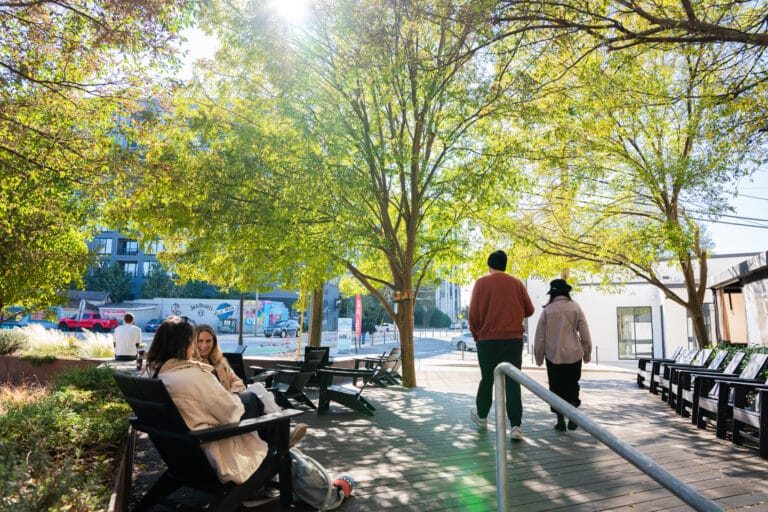Paragliding Provides Bird’s-Eye-View of the Blue Ridge
It’s a bright, blue-sky afternoon in Botetourt County, Virginia. Popcorn clouds move lazily overhead. In a grassy clearing atop a high mountain ridge are six people strapping on wings.
 Larry Dennis, a Roanoke obstetrician, is the first to launch. He tugs gently on the lines, the breeze catches the wing, and Dennis deftly maneuvers it into the air. In quick succession, the other pilots join Dennis and his purple and yellow glider, soaring above the ridge. The breeze blowing perpendicular to the mile-long ridge is deflected upward, enabling the pilots to stay aloft for an hour or more.
Larry Dennis, a Roanoke obstetrician, is the first to launch. He tugs gently on the lines, the breeze catches the wing, and Dennis deftly maneuvers it into the air. In quick succession, the other pilots join Dennis and his purple and yellow glider, soaring above the ridge. The breeze blowing perpendicular to the mile-long ridge is deflected upward, enabling the pilots to stay aloft for an hour or more.
This is paragliding, the simplest form of flight in which we humans can participate. Paragliders, and their cousin hang gliders, are foot-launched motorless aircraft capable of sustained flight. While a hang glider utilizes a rigid frame structure to give it its shape, a paraglider employs a soft fabric wing with its shape and support derived from air pressure upon it. Many free-flight pilots prefer the paraglider to the hang glider, because a paraglider can be set up for flight in a matter of minutes, and it can be packed into a large backpack and carried anywhere. Through this modest but technologically advanced form of aviation, one can launch, soar high above the valleys below, and land safely without assistance of any kind. Paragliding realizes the dreams of bird-like flight of many through the ages, including Leonardo Da Vinci, who devoted much effort to drawings for free flight.
 Pilots communicate via two-way radios and advise each other of changing weather conditions or lifting air, such as birds wheeling in the updrafts. Paragliders often share the sky with red-tailed hawks, turkey vultures, and the occasional bald eagle. When the rising columns of warm air or “thermals” move across the valley, they bring insects up with them, which in turn bring the smaller song birds which feed upon them. Flying among the birds, especially gazing down on them from above, is an unforgettable experience.
Pilots communicate via two-way radios and advise each other of changing weather conditions or lifting air, such as birds wheeling in the updrafts. Paragliders often share the sky with red-tailed hawks, turkey vultures, and the occasional bald eagle. When the rising columns of warm air or “thermals” move across the valley, they bring insects up with them, which in turn bring the smaller song birds which feed upon them. Flying among the birds, especially gazing down on them from above, is an unforgettable experience.
Control of the glider is provided by brake lines to which the pilot applies varying degrees of pressure. The pilot also shifts body weight to direct flight. An emergency parachute is built into the harness in which the pilot sits.
 The landing zone hay field lies in the valley 1500 feet below. To land a paraglider, the pilot flies away from the thermal or the ridge, leaving the “lift band” behind. Then the glider gradually descends, and the pilot guides the glider to the chosen spot. On approaching the field, the pilot flies into the wind and, just before touch down, flares the wing. If done correctly, the pilot touches down lightly on her feet and the glider collapses softly to the ground.
The landing zone hay field lies in the valley 1500 feet below. To land a paraglider, the pilot flies away from the thermal or the ridge, leaving the “lift band” behind. Then the glider gradually descends, and the pilot guides the glider to the chosen spot. On approaching the field, the pilot flies into the wind and, just before touch down, flares the wing. If done correctly, the pilot touches down lightly on her feet and the glider collapses softly to the ground.
Popular paragliding sites are located in Roanoke, Va; Washington, D.C.; Chattanooga, Tenn.; and Boone, N.C. At regional fly-ins such as the Tater Open in Boone, there can be as many as 25 gliders in the air at once. The camaraderie of the gliding community is certainly one of the greatest things about free flight.
 The sun is setting, and a few pilots are still flying, enjoying the smooth air of the evening. As the magic of the orange glow to the west spreads across the sky, the last paragliders touch down in the golden field. The pilots unfasten their harnesses and fold up their gliders, laughing and reveling in the sublime phenomenon that is free flight over the Blue Ridge. •
The sun is setting, and a few pilots are still flying, enjoying the smooth air of the evening. As the magic of the orange glow to the west spreads across the sky, the last paragliders touch down in the golden field. The pilots unfasten their harnesses and fold up their gliders, laughing and reveling in the sublime phenomenon that is free flight over the Blue Ridge. •







